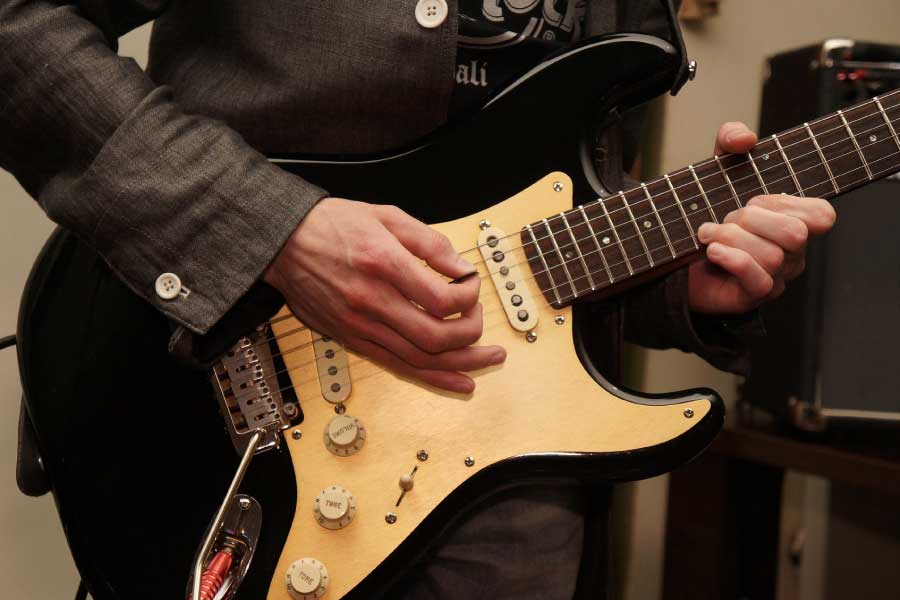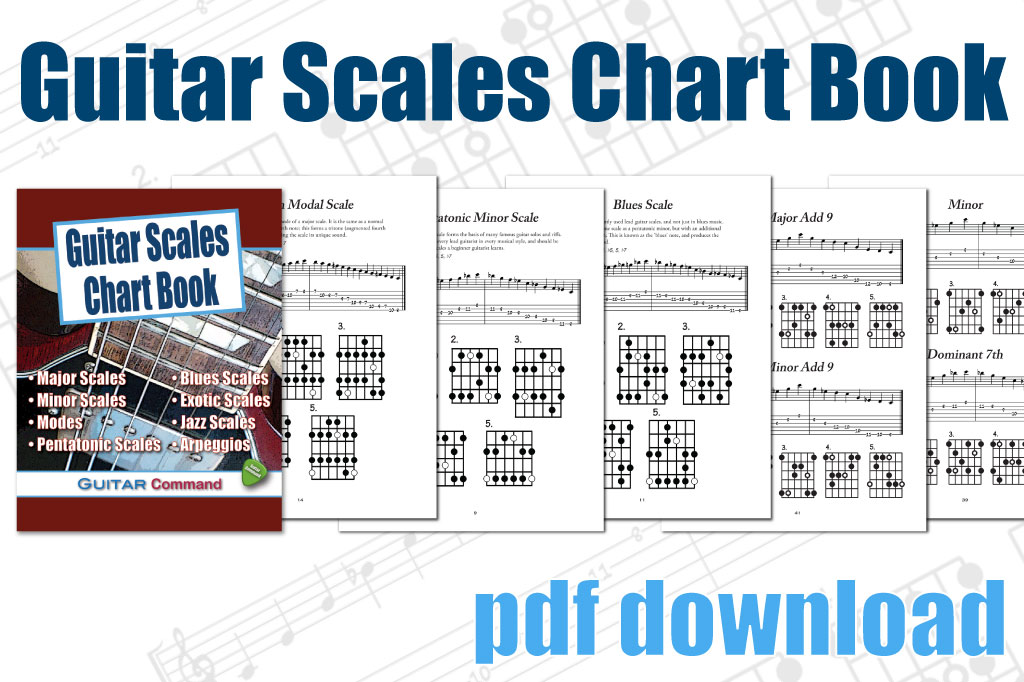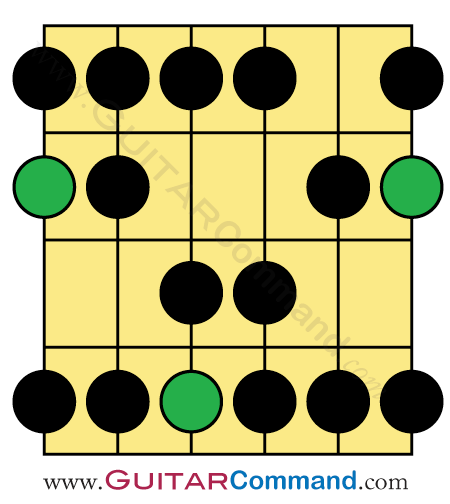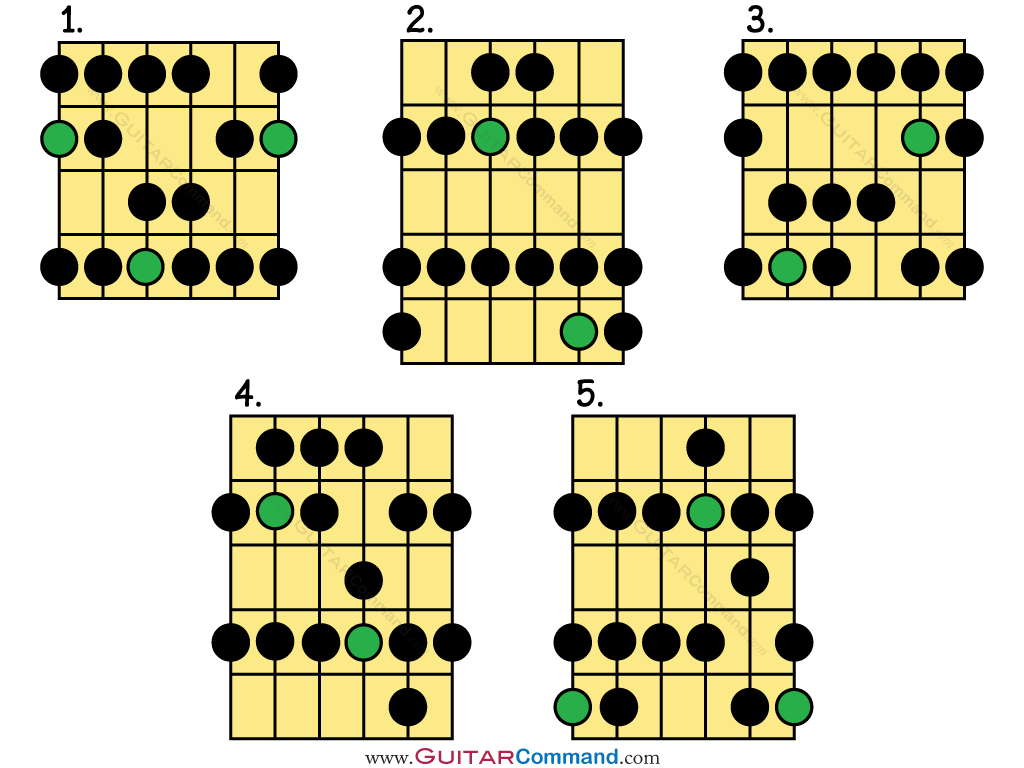On this page you’ll find a complete guide to playing the major scale on guitar.
TAB and notation has been provided along with movable scale patterns, allowing you to play all major scales - wherever you are on the fretboard.
What you’ll learn
- Open-position major scales
- The basic major scale guitar pattern.
- Four more major scale fretboard patterns.
- Why learning more than one scale pattern is beneficial.
- How the major scale is constructed.
- When to use the major scale
- You’ll also be able to practice soloing with a major scale using the backing track provided.
Let’s get started…
Page Index
- About The Major Scale
- Your First Major Scales: TAB for playing C, G and A major scales in open position
- Basic Major Guitar Pattern
- 2-Octave C Major Scale TAB (Up & Down)
- 2-Octave G Major Scale TAB (Up & Down)
- All Major Scale Patterns with Example TABs
- Why learn more than one pattern for each scale?
- Joining Multiple Major Scale Guitar Patterns
- 3 Octave Major Scale Using Multiple Patterns
- Notes In The Major Scale
- How To Use The Major Scale
- More Guitar Scale Pages At Guitar Command
Other Pages on Guitar Command
- Guitar Scales: Your Complete Online Reference Page
- Download Our Comprehensive Guitar Scales Chart Book
- Practice improvising with scales using our specially-produced Guitar Scales Backing Tracks
About The Major Scale

The major scale is the 'basic' scale in music, and is usually the first scale a beginner student – of any instrument – will learn.
It's easy to dismiss the major scale due to its 'vanilla' sound when it's played on its own, but in actual fact many of the world's best-known melodies are composed using the notes in a major scale. Guitarists in nearly all styles of music will regularly use major scales in their solos, riffs and licks.
The major scale serves as a 'foundation' for music theory and for all other scales; it's the scale other scales are compared to.
If you have a good knowledge of major scale patterns on the guitar fretboard then you'll be able to play every modal scale.
In other words, for each major scale pattern you learn, you'll be getting several other scales for free!
On this page you'll find major scale TAB, notation and patterns for playing major scales in every key all over the guitar fretboard...

Open Position Major Scale TAB
Use the following TABs to play major scales in open position (suggested fingering is provided next to each note).
- You can find out how to read guitar tab here: How To Read TAB
1 Octave C Major Scale in Open Position

1 Octave G Major Scale in Open Position

1 Octave A Major Scale in Open Position

2 Octave G Major Scale in Open Position

Basic Major Guitar Pattern
- You can find out how to read scale patterns on this page: Guitar Scale Patterns
By learning a scale as a pattern you'll be able to play that scale with any tonic note*.
In other words, by learning a single major scale pattern (for example the basic pattern shown below), you'll be able to play any major scale, be it a C major, D major, E major, etc. You simply move your fretting hand to the correct position on the guitar neck and play the notes as shown on the pattern.
- In order to be able to do this, you'll need to know where the notes are on the fretboard. You'll find a useful diagram showing every note on the fretboard here: Guitar Strings Notes
* A 'tonic note' of a scale is the 'name' note, i.e. the 'C' notes in a C major scale, the 'G' notes in a G major scale, etc.)
The pattern below is the basic major scale pattern. TABs have been provided showing how this pattern can be used to play both a C and a G major scale. You could also move the scale to other frets in order to play other major scales.
Further down the page you’ll find four additional major scale patterns and tabs.

The fingering shown in the diagram above can be used to play a major scale with any starting note.
You may have noticed that the scale pattern above includes 2 additional notes that extend the scale in either direction.
Scale diagrams often include notes that are either above or below the tonic notes in this way. This is because you’ll usually be using the scale while improvising, so knowing the extra notes available in that fretboard position can be useful.
If you just want to play the scale then start and stop on the green tonic notes, ignoring the extra notes outside of the green notes.
2-Octave C Major Scale TAB (Up & Down)
Play the pattern in seventh position (i.e. so your index finger is positioned over the 7th fret) for a 2-octave C major scale, as shown in the TAB below.
(In this position your second (middle) finger will be positioned over the 'C' note at the 8th fret of the 6th (lowest) string, which is the first note in the scale.)

- More information on scale patterns can be found on this page: Guitar Scale Patterns
2-Octave G Major Scale TAB (Up & Down)
Here’s the same major scale pattern being used to play a G major scale:

All Major Scale Patterns
The diagram below shows the first major scale pattern together with four more patterns. We’ll take a closer look at each of the new patterns below.

The basic major scale pattern (pattern 1) can be extended up and down the guitar fretboard using the additional scale patterns. You’ll see how to join the patterns up in order to create longer lines further down the page.
A tab example has been provided for each of the new patterns. The tab shows how the pattern can be used to play either a 1 octave or a 2 octave C major scale. (Patterns 1 & 5 span 2 octaves, the others a single octave.)
Remember that the scale patterns may contain notes that extend the scale, either upwards or downwards. If you just want to play a single octave, play from a green note to the next green note, as shown in the tabs below.
Major Scale Pattern 2

Play this pattern in 9th position (i.e. position your hand so that the index finger is ready to play at the 9th fret), starting and stopping on the green notes, for a 1-octave C major scale:

Major Scale Pattern 3

The TAB below shows how pattern 3 can be used to play a 1-octave C major scale in 12th position.

You could also play this pattern an octave lower in open position, as shown below:

Major Scale Pattern 4

Play this pattern starting at the 3rd fret of the A string for a C major scale, as shown in the TAB below:

Major Scale Pattern 5

Playing this pattern starting in 5th position will result in a C major scale, as shown in the TAB below. (You'll need to shift position (one fret lower) to play the notes on the G string):

Why learn more than one pattern for each scale?
Guitarists learn more than one scale pattern for each scale so that they can play the scale in different octaves and at different positions on the guitar neck.
For example, if you only knew the basic major scale pattern (pattern 1) and were improvising over a chord progression in C, then you’d be limited to playing in 7th position (i.e. with your index finger positioned over the 7th fret.)
If you also knew major scale pattern no. 3, then you could also improvise using a C major scale in open position, or in 12th / 13th position. This would give you access to several more notes.
Joining Multiple Major Scale Guitar Patterns
When playing with scales, you can extend your lines by linking together adjacent scale patterns. Below you’ll find a TAB example of this, with suggested fingerings.
Extending / Combining Major Scale Patterns

This is just one of many ways you can join major scale patterns to make longer lines.
Experiment linking each of the five patterns with its neighboring patterns to create your own extended lines.
Notes In The Major Scale
The major scale is a heptatonic scale, which means it contains seven notes per octave. Most scales - especially those used in Western music - are heptatonic, but there are notable exceptions, such as the five note per octave pentatonic scales, which are widely used in rock and pop music.
Notes in a major scale as intervals to the tonic note:
- Tonic note
- Major 2nd
- Major 3rd
- Perfect 4th
- Perfect 5th
- Major 6th
- Major 7th
The intervals between notes in a major scale:
- (Note 1: starting note, no interval)
- Note 2: whole tone / whole step from preceding note
- Note 3: whole tone / whole step from preceding note
- Note 4: semitone / half step from preceding note
- Note 5: whole tone / whole step from preceding note
- Note 6: whole tone / whole step from preceding note
- Note 7: whole tone / whole step from preceding note
- Note 8 (octave): semitone / half step from preceding note
Major Scale Formula
The major scale is the scale against which all others are compared. Therefore its scale formula is: 1, 2, 3, 4, 5, 6, 7
The notes in a C major scale:
- Tonic note = C
- Major 2nd = D
- Major 3rd = E
- Perfect 4th = F
- Perfect 5th = G
- Major 6th = A
- Major 7th = B
… and the notes in G major scale:
- Tonic note = G
- Major 2nd = A
- Major 3rd = B
- Perfect 4th = C
- Perfect 5th = D
- Major 6th = E
- Major 7th = F sharp
How To Use Major Scales
The major scale, when compared to other scales with a major tonality (such as the Phrygian scale, and the Mixolydian scale, has a somewhat ‘neutral’ tone.
This makes it less ‘characterful’ but perhaps more versatile than other scales, because it can be used over a greater number of chord progressions. (Other scales may contain notes that sound 'wrong' over certain chords.)
A major scale with a particular tonic note can be used to solo over chord progressions than contain chords diatonic to that major scale.
- You can find out what diatonic chords are here: Diatonic Chords
For example, you could use a C major scale to solo over the following chord progression, because all of the chords in the progression are diatonic to C major.
||: C | G | F | Am| Em | F | Dm | G7 :||
Discover More Guitar Scales At Guitar Command
Visit the following pages on Guitar Command to find out more about guitar scales and how to use them in your own playing:


Wish I could get these I have played 3 years and quit for 2. Just now comomg back and know it is imporant to know your scales. Well worth the money and time of learning.
Thanks very helpful
Thanks for the scales – just what I needed. So great they’re all in one place.